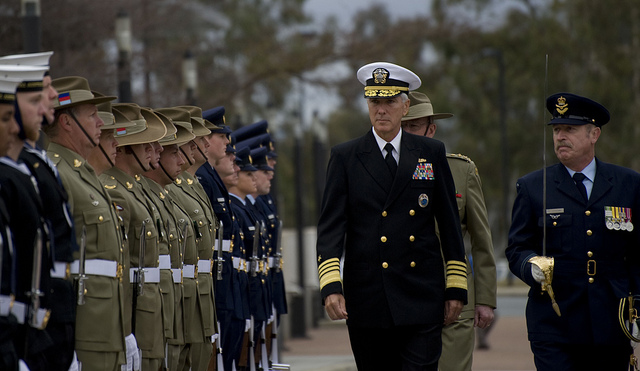
One of the key questions US allies and partners have been asking is whether America will actually be able to pull off the Asia–Pacific ‘pivot’. More than twelve months after the announcement there are doubts persist all around; whether the US as a global power can afford to shift more military assets from the Middle East to the Asia Pacific, whether
growing pressure on the US defence budget might render the ‘pivot’ (or ‘rebalance’) unsustainable anyway, or even if the political will exists to persist in the face of rising Chinese power. However, a good case can be made that the ‘rebalance’ is not only in full swing but will also be sustainable in the long-run.
First, a shift of military assets away from other regions towards the Asia Pacific is already underway. US ongoing strategic interests in the Middle East and elsewhere don’t require a massive military footprint. As the Pentagon’s
2012 Defense Strategic Guidance made clear, major US land wars are a thing of the past. Deterring potential Iranian attempts to overthrow the regional status quo does not necessarily depend on the forward deployment of strategic assets such as aircraft carriers. In fact, provided US aerospace forces in the Gulf are reinforced,
US deterrence vis-à-vis Iran could be more credible without high-value targets such as carriers. Moreover,
counterterrorism operations in Africa and South America will be conducted by a mix of special forces and CIA operatives. And European NATO allies such as France and the United Kingdom have stepped up their leadership in military operations in Northern Africa and the Levant.
As a result, the US has already reduced its presence in the Middle East by one aircraft carrier and some destroyers. The chief of naval operations,
Admiral Jonathan Greenert also recently told US Congress of plans to withdraw two amphibious warships and two frigates from the waters off Africa, and to reduce the numbers of ships in the US Southern Command to zero. At the same time, US forces redeploy towards our region. The new Littoral Combat Ships (LCS) are on their way to be forward deployed in Singapore. There have also been moves to further strengthen the American presence in Japan and South Korea. Joint war games and training exercises in East Asia and elsewhere will go ahead as scheduled. And USPACOM Commander,
Admiral Samuel Locklear testified that his permanently-assigned ground forces are ‘resetting their focus in the Indo-Asia-Pacific’, while the III US Marine Expeditionary Force had ended its world-wide service rotations, allowing them to ‘once again concentrate on Pacific theater missions.’ The US seems indeed willing to
systematically prioritise capabilities required for the Asia–Pacific theatre.
Moreover, the doom and gloom in the Pentagon and among some US policymakers about the budget cuts irreversibly crippling America’s military are vastly overblown. True, money will be tighter in the coming years. But as a
new study by The Hamilton Project argues, the real crisis for US defence spending is ‘not downward pressure on the defense budget, but rather problems from
within that budget’. These problems can be fixed by systematically redesigning forces for the new security challenges and by creating a more effective and efficient defence acquisition system—admittedly easier said than done. But, even if the much discussed ‘sequester’ takes effect in the medium to longer term, the US is set to outspend any other power, including China, by a wide margin.
The Hamilton Project authors also state that militarily America is ‘not about to be overwhelmed nor have we fallen behind potential challengers’ (read: China). Yes, the US Pacific Navy will probably not be able to arrest its
long term decline and dramatically increase its fleet beyond today’s 290 major combatants. But it doesn’t have to; its combined agility, firepower and operational reach allow it to dominate large parts of the Western Pacific and at least deny Chinese forces from establishing sea control in contested maritime spaces. And America’s new ‘
AirSea Battle’ operational concept signals to China that it won’t be deterred from accessing some future East Asian crisis, based on an emerging US Navy paradigm of ‘the
many, the cheap(er), and the unmanned’. A combination of forward deployed troops and ‘offshore balancing’ (eg the ability to strike from safe distances) will allow the US to sustain a powerful presence in Asia to deter major power war.
Moreover, the ‘pivot’ is scalable. That’s to say, it can be adapted to changing strategic circumstances. At this point of time, a modest strengthening of the US presence in Asia is just about right. Anything else would smack of a disproportionate response to China’s military rise. Washington is
not containing Beijing. Indeed, as
ASPI visiting scholar Ross Terrill argued recently on this blog , America’s view of China is still very much predicated on the hope that China will become a ‘responsible stakeholder’. Should China ever turn into a truly revisionist power, America certainly has the capacity to enter into an Asian 'Cold War'. But until then, the pivot’s true significance is not a rapid increase of US military capabilities in Asia but in the political message it sends: the US will remain engaged in this region for a very long time. Finally, the US would want to avoid the impression among some allies, including Australia that it will continue to shoulder most of the burden.
Benjamin Schreer is a senior analyst at ASPI. Image courtesy of Flickr user #PACOM.[4] US deterrence vis-à-vis Iran could be more credible without high-value targets such as carriers.: http://www.defensenews.com/article/20130310/DEFFEAT05/303100007/Getting-Carrier-Out-Gulf-Good-U-S-Iran-Policy
[8] systematically prioritise capabilities required for the Asia–Pacific theatre: http://www.defensenews.com/article/20121024/DEFREG02/310240005/U-S-Spending-Shifts-Demands-Asia-Pacific-Theater
 Print This Post
Print This Post